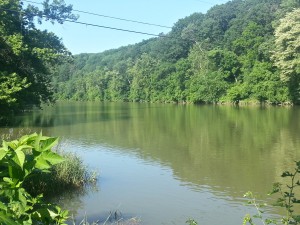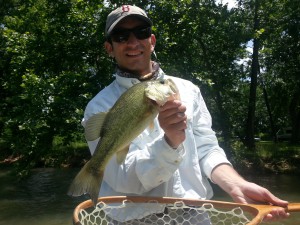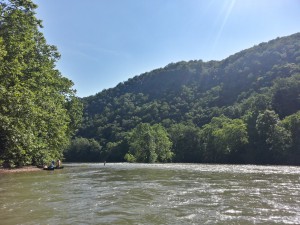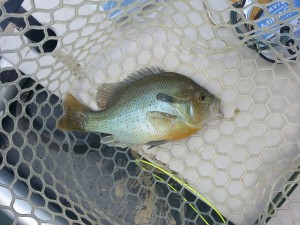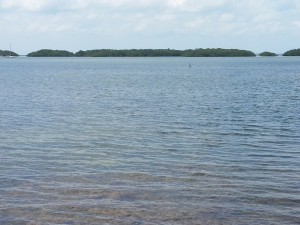This summer has been pretty busy, so when I realized I had a spare weekend day to hit the water, all I wanted to do was head out to the Shenandoah Valley and catch some fish. I started calling up some guides, and luckily, despite only having about a week’s notice, Scott from Albemarle Angler was available for a full day trip this past Saturday. As the trout season was dwindling down, Scott suggested we do a smallmouth float – which was fine by me since Smallies are one of my favorite fish to catch, period. We decided on a several mile stretch right out of Shenandoah, VA.
In the days before the trip, I started getting a little nervous. A big storm was supposed to roll through Thursday, and I began suspecting the river would get blown out. Luckily, it tracked just far enough to have a minimal impact on the water levels. Scott called me the day before the trip for finalize details, and he said the water would be high, but fish-able. Disaster averted.
I met up with Scott at the boat launch and discovered the water had a bit more color than we were expecting. We didn’t think we’d have crystal clear water (and frankly, didn’t really want it), but the water had maybe about a foot of visibility. Yikes. It looked like I was going to have a challenging day ahead of me. We got our rods rigged up – two with floating lines, and one with a sinker – and Scott pushed us off and down the river.
The morning was tough. We threw almost everything in our collective fly boxes and couldn’t get so much as a strike. We tried clousers, worms, hellgramites, hogsuckers, small flies, big flies, purple flies, black flies, green flies… and the fish just plain ignored it. Or didn’t see the fly. It was a rough first few hours, but at least I was outside and relaxing. The morning grew older, and I still hadn’t gotten a strike. Trying to find something that would work, Scott found a nice feeder creek, and anchored us up at the confluence. It had everything we could want – clearer water, an eddy, and some dead water too. Scott pointed out exactly where to toss my fly, but my luck still didn’t change.
We spent a good 10 minutes on this spot changing out flies, but I just couldn’t convince the fish I’d give them another day to live if they just bit my fly. Scott was certain this was the spot though. He picked up his rod, rigged up with a Kreelex, and tossed it out as well to double our odds and find what the fish were biting. A couple casts later, and he connects! He quickly hands the rod over to me, and I pull in a BIG sunfish. It wasn’t a smallmouth, but at least we got the skunk off the boat. He tells me to keep fishing that fly now that we got a bite. I make my next cast, and WHAM! Another hit – this one a lot stronger. After a nice battle, Scott netted a great size largemouth bass!
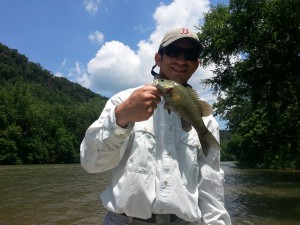 We kept on that spot for another 20 minutes or so. I ended up connecting with our first smallmouth of the trip, and a second one shortly thereafter. We left the confluence shortly after I nailed another big sunfish. Armed with our knowledge of the recipe for success, we moved on for some new water. It wasn’t too long before I felt that tug and set the hook on another smallmouth. This guy struggled, danced, and tried to jump his way off the hook, but he was no match for us. A few photo ops, and he was off to swim another day. I was really hoping he’d tell his buddies to come play.
We kept on that spot for another 20 minutes or so. I ended up connecting with our first smallmouth of the trip, and a second one shortly thereafter. We left the confluence shortly after I nailed another big sunfish. Armed with our knowledge of the recipe for success, we moved on for some new water. It wasn’t too long before I felt that tug and set the hook on another smallmouth. This guy struggled, danced, and tried to jump his way off the hook, but he was no match for us. A few photo ops, and he was off to swim another day. I was really hoping he’d tell his buddies to come play.
Scott and I started to feel our stomachs grumble a bit, so we pulled over for lunch – which was included in the cost of the trip. Scott brought the coolers on shore broke out some chips, and opened the cooler. I expected something nice and simple, like a deli sandwich. Next thing I know, Scott is breaking out a portable gas grill! The menu was not ham sandwiches today. We were talking gourmet, freshly grilled burgers topped with cheese, bacon, sauteed onions and sauteed mushrooms on ciabatta! It tasted just as great as it sounds, too. Normally, I wouldn’t even write a sentence about the lunch on a one-day fishing trip, let alone a whole paragraph, but I felt it was important. It can often be difficult to differentiate good guide services from great ones, or great ones from the best – but to me, such a specialized touch makes it tough to parallel. Sorry, Scott, hopefully I didn’t set the bar too high for you for the future!
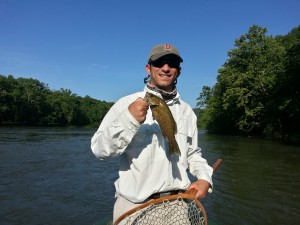 After lunch, we set off for more battles. We kept the Kreelex on the line, and that kept the smallmouths on the line. Scott did great work constantly picking out the eddies and pockets he wanted me to fish. Each time, I would drop a fly in and get a hit. Scott even put up with me occasionally casting into the trees. He’d dutifully row the boat over for me to free up my fly. Of course, I would always pick my opportunity to get the fly caught up when we were in the fastest water and it was toughest for Scott to row. Our fears of a slow day turned into Scott commenting on the great numbers we put up – at least for the conditions. I didn’t really count, but I would guess we had at least 15 smallies to the raft by the end of the float. Add those on to several bruiser sunfish and the largemouth, and it was plenty to keep me entertained! I had a great experience with Scott. He has quite the fishing background having spent a significant time both out west and in the Shenandoah area. I’m already determined to get out with Scott and Albemarle Angler for another float this summer, and am looking forward to giving them a try when the trout start biting again.
After lunch, we set off for more battles. We kept the Kreelex on the line, and that kept the smallmouths on the line. Scott did great work constantly picking out the eddies and pockets he wanted me to fish. Each time, I would drop a fly in and get a hit. Scott even put up with me occasionally casting into the trees. He’d dutifully row the boat over for me to free up my fly. Of course, I would always pick my opportunity to get the fly caught up when we were in the fastest water and it was toughest for Scott to row. Our fears of a slow day turned into Scott commenting on the great numbers we put up – at least for the conditions. I didn’t really count, but I would guess we had at least 15 smallies to the raft by the end of the float. Add those on to several bruiser sunfish and the largemouth, and it was plenty to keep me entertained! I had a great experience with Scott. He has quite the fishing background having spent a significant time both out west and in the Shenandoah area. I’m already determined to get out with Scott and Albemarle Angler for another float this summer, and am looking forward to giving them a try when the trout start biting again.
Ready to book with Albemarle Angler? Be sure to leave a review if you try them out! They can be reached at albemarleangler@gmail.com via email or by phone at (434) 977-6882. Rates for a full day floats are $350 including lunch, and wading trips start at $225 for a half day. Albemarle Angler targets smallmouth bass from mid-March through mid-October, and trout (brook, brown, rainbow, and tiger trout!) from mid-September to mid-June depending on water flows. They fish the Shenandoah and James Rivers for smallmouths, and various rivers, streams, and creeks (including some private water) for trout. Albemarle Angler is also a full service fly shop located at 1129 Emmet St, Charlottesville, Virginia, 22903. As if all that wasn’t enough, they also coordinate fly fishing trips across the globe.
